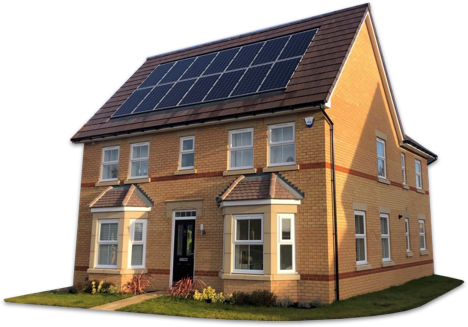Coloured solar panels are designed with different colours to the standard black or blue. Solar power generates free electricity that cuts energy bills, helps combat climate change, and potentially adds value to homes, yet some people may think twice about installing solar panels because they don’t like how they look.
A solar array is often a prominent feature of a house, taking up significant roof space, so its colour is often an important visual consideration. If you’re thinking about going solar, you may have noticed most neighbours’ solar panels are black or blue (there’s good reason for this, as we’ll soon see).
But other colours of solar panel are available, albeit currently to a limited extent in the UK. These colours may blend in better with your roof and suit your aesthetic tastes. For the more adventurous, solar panels could be chosen in a colour that stands out to make a style statement.
This post will help you decide whether coloured solar panels could be a good choice for you and your home, if not now, then in the future.
- Create a Tailored Quote Based On Your Circumstances
- Takes Less Than 2 Minutes
- Fixed-Online Quotes

What Are Coloured Solar Panels?
This question isn’t as ridiculous as it seems, and it’s one that returns nearly 290 million Google results. When people refer to “coloured solar panels”, they’re thinking about solar installations that are deliberately designed to be a different shade than the standard blue or black panels.
Solar panels aren’t black or blue because of an aesthetic choice by the manufacturers. These colours are a result of the manufacturing process, which alters the natural greyish shade of silicon solar cells.
Two main types of solar cells are used in solar panels: monocrystalline or polycrystalline. Black solar panels have monocrystalline solar cells while blue panels have polycrystalline solar cells. However, these colours can be changed with dyes or coatings to produce a broad spectrum of different shades.
Whether you’re happy with a black or blue solar array on your roof, or you’d prefer a different shade, you can explore solar panel colour options here.
Black Solar Panels
Monocrystalline solar panels, with single crystals of pure refined silicon, are immediately identifiable by their deep black colour. As the most widely used type of solar panels for homes because they’re the most energy efficient, they capture more sunlight than polycrystalline solar cells. This happens because black solar panels absorb all wavelengths of light and reflect none.
Mono solar cells have an efficiency rating of up to 25% and can last upwards of 40 years, but they do cost more than polycrystalline solar panels.
Blue Solar Panels
Polycrystalline solar panels, with multiple silicon crystal fragments, react to light to create a shimmering dark blue colour.They cost about 20% less than black, monocrystalline panels but don’t last as long – 25 to 30 years on average. However, it costs less to maintain and repair poly panels.
Because polycrystalline panels are less efficient than mono panels, more of them are needed to achieve the same power output.
Solar Panels with Non-Standard Colours
Interest in solar energy systems in various colours besides blue or black grew with developments such as the Tesla Solar Roof design.
In 2017, Elon Musk’s US multinational clean energy giant announced it had developed solar panels that looked like regular roof tiles. This sparked speculation and rumour that solar panels with a wide range of styles and colour options could soon be on the market. However, Tesla Solar Roof tiles subsequently became available in only black or blue and in limited textures and design styles.
Solar panels in various colours are now available on the market, although the current technology is substantially less efficient and more expensive than black or blue solar panels. Additionally, you’ll likely have to find a specialised solar installer to work with you at the design stage.
That said, solar technology is constantly advancing, and some companies are working on coloured solar panels that reduce efficiency loss.
Why Choose Coloured Solar Panels?
The main reason for preferring solar panels that are neither black nor blue is to have a solar array that matches the roof and its surroundings.
It’s technically possible to produce solar panels in colours to match any building. Brick-red, grey, or brown, for example, could be good options, with orange a possibility for roofs with terracotta tiles. Green solar panels, on the other hand, may be a good fit in a rural location or if you have a garden with plenty of foliage.
In fact, solar modules can be designed in all possible shades in the RAL colour management system, from tones of white, yellow, pink and beige, to magenta, violet, mauve, and mahogany. The bolder vibrant shades may appeal to homeowners who’re looking for a solar installation that will stand out.
Coloured Solar Panel Costs and Efficiency
Coloured solar panels vary in price but are always more expensive than regular black or blue panels. Pricing depends on the colour or colours you prefer. Solar arrays with multiple colours, or panels with a marbled effect, cost more than single-colour panels.
A further cost consideration is return on your investment. Dyes and coatings can reduce solar panel efficiency by up to 45%, meaning it will take longer for coloured solar panels to start paying for themselves through savings on energy bills.
However, new, experimental solar technologies are being explored to create more efficient coloured solar panels.Researchers in the Netherlands, for example, have developed a lithography technique that makes a solar panel reflect a specific colour while reducing efficiency loss.
Aesthetics Vs Cost
The aesthetic advantage of coloured solar panels comes at a price. Initial costs are higher than regular solar panels and coloured panels are also less efficient. This means you have to rely more on the national grid for expensive electricity.
Another issue at the moment is availability. Coloured solar panels are currently more common in the US and some parts of Europe than in the UK, where they’re often limited to smaller, specialist manufacturers.
But as solar technology advances, a wider range of solar panel colours could be on offer in the not-too-distant future, and at more reasonable prices. Some homeowners may be willing to accept lower energy efficiency if their solar panels have more visual appeal.
Meanwhile, regular solar panels without dyes or coloured coatings will remain the best option for homeowners looking to cut energy bills in the most economic way.
- Create a Tailored Quote Based On Your Circumstances
- Takes Less Than 2 Minutes
- Fixed-Online Quotes

















